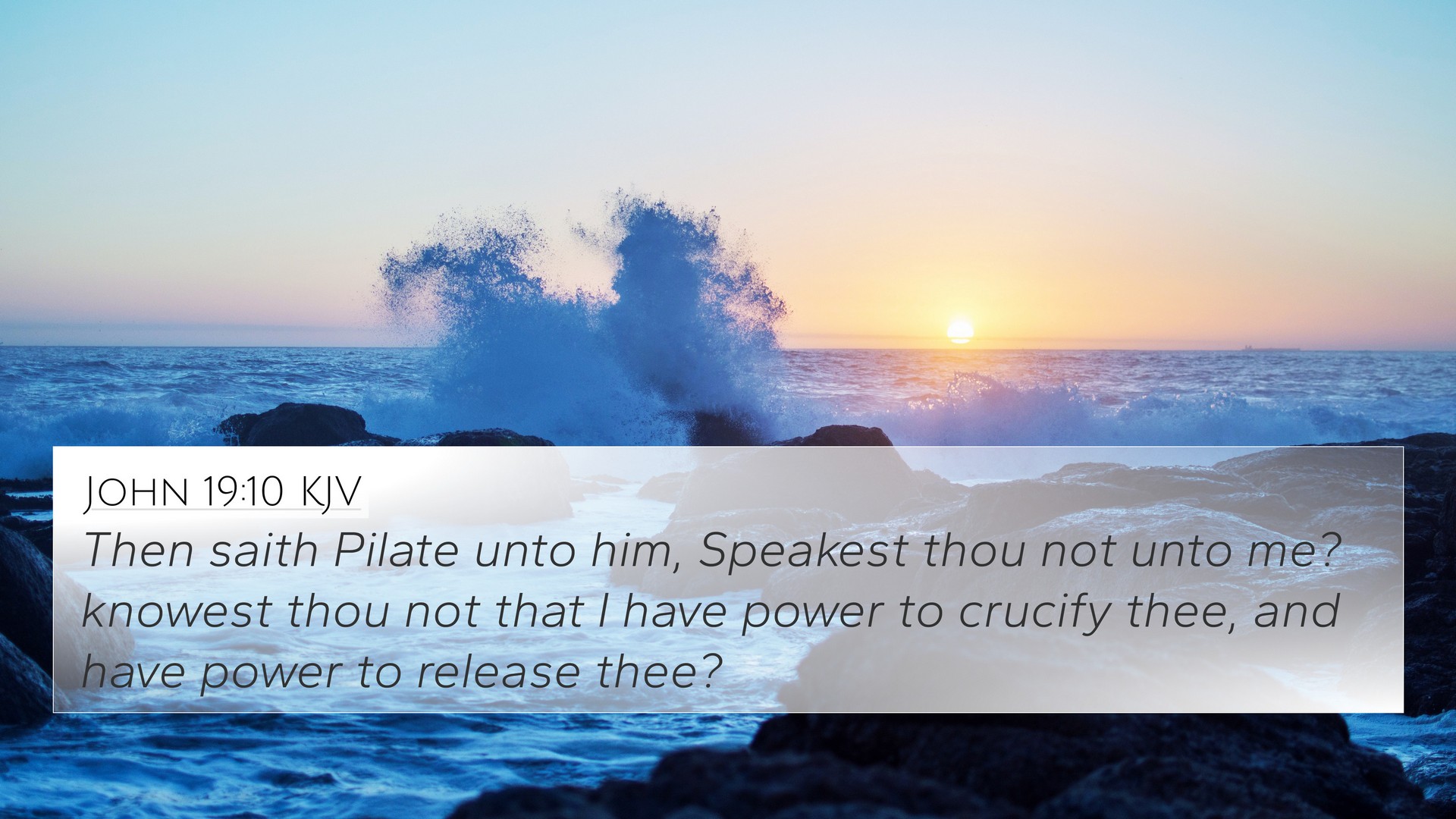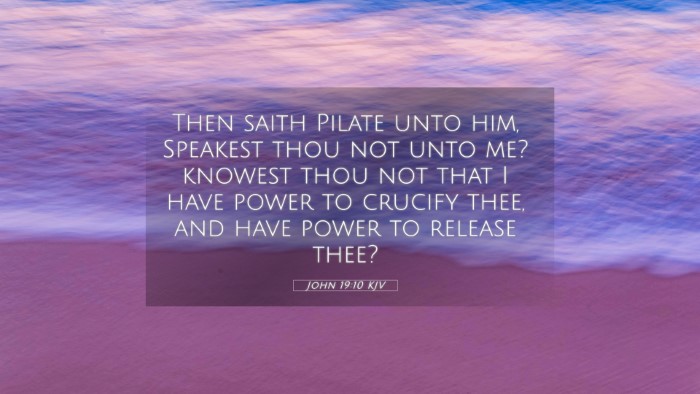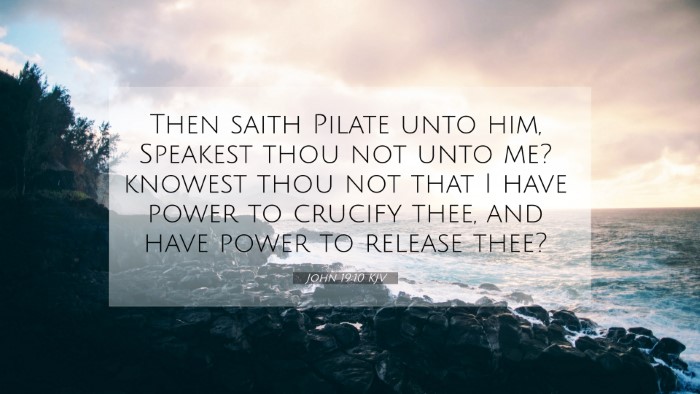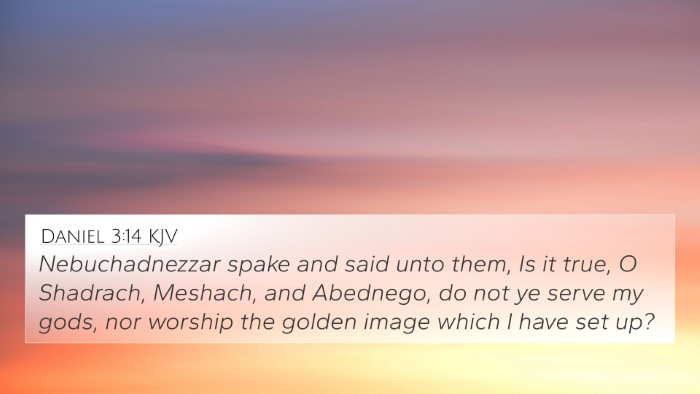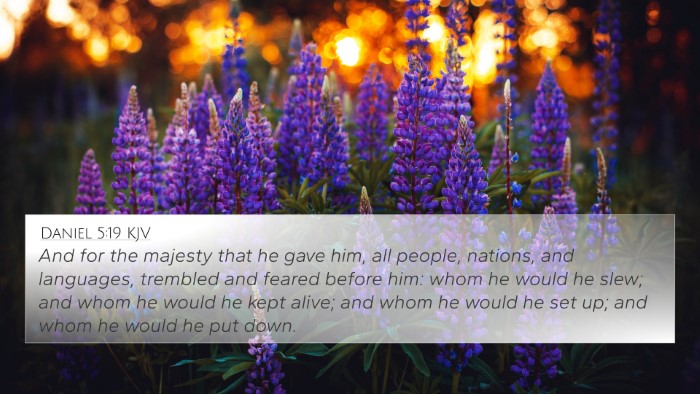Understanding John 19:10
Verse Context: John 19:10 states, "Then said Pilate unto Him, Speakest thou not unto me? knowest thou not that I have power to crucify thee, and have power to release thee?" This verse conveys the tension between earthly authority and divine sovereignty during the trial of Jesus.
Summary of Meaning
This verse captures a critical moment in the trial of Jesus before Pilate. Pilate, a Roman governor, expresses his frustration at Jesus’ silence in response to his questioning. There are several layers of meaning in this moment, focusing on the themes of power, authority, and fulfillment of prophetic scripture.
Key Themes
- Authority of Pilate: Pilate believed he held the power to determine Jesus' fate. This underscores the struggle between human authority and divine purpose.
- Silence of Jesus: Jesus' silence in the face of accusation highlights His submission to God's plan and prophecy.
- Crucifixion Prophecy: The events surrounding Jesus’ trial were foretold in the Old Testament, demonstrating God's plan for redemption through Jesus’ crucifixion.
Commentary Insights
Matthew Henry
Henry points out the irony that Pilate, who seems to possess authority, is actually under the sovereign control of God’s will. His power is merely superficial, rooted in the politics of the moment, whereas Christ's silence indicates His submission to divine purposes.
Albert Barnes
Barnes emphasizes Pilate’s misunderstanding of true power. He notes that while Pilate claims authority over Jesus’ fate, it is actually God who holds ultimate authority, as Jesus Himself stated that no one could take His life from Him; He laid it down willingly (John 10:18).
Adam Clarke
Clarke articulates the psychological state of Pilate, conveying a sense of desperation as he tries to assert his control over the situation. He highlights the futility of Pilate’s power in the face of divine destiny, reminding readers that God’s plans are unstoppable.
Cross-References
John 19:10 connects with several other scriptures, illustrating the broader narrative of authority, prophecy, and divine sovereignty. Here are some relevant cross-references:
- Matthew 27:11-14: Jesus before Pilate, remaining silent.
- Mark 15:2-5: Pilate’s questioning and Jesus’ responses.
- Luke 23:8-9: Herod's curiosity about Jesus, reflecting the wider intrigue during the trial.
- John 10:18: Jesus speaks of His power over life and death.
- Isaiah 53:7: Prophetic reference to the silent suffering servant.
- Acts 4:27-28: Recognition of God’s sovereignty over the events leading to the crucifixion.
- Philippians 2:9-11: The ultimate authority of Christ over all.
Connections Between Bible Verses
John 19:10 serves as a pivotal verse that can be explored through various connections between Bible verses. Understanding this verse through these connections enhances our interpretative lens. Below are key cross-referencing methods for deeper study:
- Bible Concordance: Use a Bible concordance to locate thematic references and keywords related to authority and sacrifice.
- Comparative Bible Verse Analysis: Analyze how different Gospel accounts present the trial of Jesus to gain a fuller picture of His trial and crucifixion.
- Cross-References for Sermon Preparation: Use John 19:10 as a focal point to prepare sermons that explore the doctrines of power and submission to God’s will.
Thematic Bible Verse Connections
The thematic connections from John 19:10 can lead to a rich exploration of theological concepts such as:
- Power and Authority: Understand how different scriptures discuss divine vs. earthly power; see Romans 13:1.
- Fulfillment of Scripture: Explore verses that affirm the necessity of the crucifixion, like Genesis 3:15 and Zechariah 12:10.
- Submission of Christ: Connect with the understanding of Jesus' submissive role in various scriptures, like Hebrews 10:5-10.
Conclusion
In summary, John 19:10 serves as a profound reminder of the intricate interplay between human authority and divine sovereignty. The silence of Jesus reflects the fulfillment of God's plan through His sacrificial death. By utilizing tools for Bible cross-referencing, believers and scholars alike can establish deeper connections and gain nuanced insights into this pivotal moment.
Exploring More Bible Cross-References
For those interested in further studying the themes, context, and related scriptures, consider digging deeper into the following areas:
- Identifying connections between Old and New Testament: Trace themes of sacrifice throughout the scriptures.
- Cross-referencing Biblical texts: Use resources like thematic Bibles to explore extensive cross-reference materials.
- Detailed cross-reference between Gospels: Compare the narrative flow across each Gospel account for divergence and alignment.
